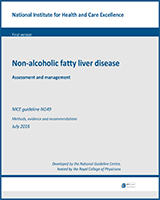NCBI Bookshelf. A service of the National Library of Medicine, National Institutes of Health.
National Guideline Centre (UK). Non-Alcoholic Fatty Liver Disease: Assessment and Management. London: National Institute for Health and Care Excellence (NICE); 2016 Jul. (NICE Guideline, No. 49.)
Background
Primary non-alcoholic fatty liver disease (NAFLD) is an excess of fat in the liver (steatosis) that is not a result of excessive alcohol consumption or other secondary causes. These secondary causes include, for example, side effects of certain medications, hepatitis C virus infection and particular endocrine conditions. NAFLD progresses from hepatic steatosis, through inflammatory non-alcoholic steatohepatitis (NASH), to fibrosis or cirrhosis. A proportion of people with NAFLD will die from liver failure or hepatocellular carcinoma (HCC), or need a liver transplant.
The prevalence of NAFLD in the general population is estimated at 20–30%.209,210,229 Around 2–3% of the population have NASH.229 NAFLD is more common in people who have central obesity (excessive abdominal fat), insulin resistance or type 2 diabetes, hypertension and dyslipidaemia. This group of chronic conditions is indicative of increased cardiovascular risk and together comprise ‘metabolic syndrome’.
The prevalence of NAFLD is increasingly placing a greater burden on healthcare resources.209,210,229 The rate of progression of NAFLD is variable; being overweight and having diabetes are associated with an increased risk of progressive disease. The average age of people with NASH is 40–50 years and for NASH-cirrhosis, 50–60 years. However, the emerging epidemic of childhood obesity means that increasing numbers of younger people have NAFLD, with some prevalence studies showing that up to 38% of obese children have evidence of NAFLD. With NAFLD progressing through its spectrum even in childhood, the age that people develop significant liver disease is likely to fall and early diagnosis and management are therefore important issues at all ages. There is currently no pharmacological treatment licensed for NAFLD.
Current practice
NAFLD is usually first suspected in primary care incidentally either by abnormal liver blood tests or an abnormal liver ultrasound appearance picked up as part of an investigation for an unrelated condition. The care pathway in primary care for someone with suspected NAFLD is unclear, and practice regarding further investigation and referral varies widely. NAFLD is increasingly being identified through case-finding in hospital outpatient departments for people with associated conditions such as diabetes, obesity or hypertension. However, this practice is not universal and there is no guidance about which people should be investigated for NAFLD or how this should be done. Once people with NAFLD have been referred to secondary care, their condition may be investigated further to determine whether or not they have progressive disease. However, as there is currently no guidance about whom or how to investigate these people, investigation tends to be ad hoc. As there is currently no licensed treatment for NAFLD, most people are discharged back to their GP. Some people are given advice on lifestyle, which is usually focused on achieving weight loss, but, again, in the absence of clear guidance, this is highly variable.
Need for and scope of the guideline
Guidance is needed for use in both primary and secondary care settings.
This guideline covers identifying, diagnosing and assessing disease severity in adults, children and young people with NAFLD. It also covers both pharmacological and non-pharmacological treatments, disease monitoring and the risk of extra-hepatic conditions associated with NAFLD.
The guideline does not cover the investigation of people with incidentally found abnormal liver blood tests, of which NAFLD is but 1 of the common causes, and does not cover the complications of NAFLD cirrhosis.
Some people with NAFLD may also have an additional aetiology of liver disease that may be equally as significant (or even more significant) as a cause of liver injury and fibrosis, for example, co-existing chronic viral hepatitis. However, specific details regarding assessment and management of such people are also outside of the scope of this guideline.
Although HCC has been reported in people with NAFLD without cirrhosis, its likely very low incidence was not felt to merit consideration of the cost-effectiveness of surveillance for this complication.
NICE has produced guidance on the components of good patient experience in adult NHS services. All healthcare professionals should follow the recommendations in Patient experience in adult NHS services.
Although there are many causes of steatosis, and therefore a potentially wide differential diagnosis in practice, the principal difference is between primary, metabolic syndrome-related NAFLD and alcohol-related liver disease. Discriminating between these is reliant upon a detailed history and seeking corroboration from family members, where available, to ensure that any history of occult excessive alcohol consumption is excluded. An arbitrary threshold for ethanol consumption of <20 g/day for women and <30 g/day for men is adopted to sustain a diagnosis of NAFLD. For people with abnormal liver blood tests and either suspected or confirmed fatty liver, alternative causes must be excluded with a detailed drug history and laboratory tests for chronic viral hepatitis (HBVsAg and HCV serology), autoimmune liver disease (ANA, AMA, SMA, LKM1 antibodies, immunoglobulins) and other treatable metabolic diseases (haemochromatosis, Wilson's disease, coeliac disease, alpha-1 antitrypsin deficiency). Importantly, 80% of people with NAFLD have normal standard liver blood tests.
- Introduction - Non-Alcoholic Fatty Liver DiseaseIntroduction - Non-Alcoholic Fatty Liver Disease
Your browsing activity is empty.
Activity recording is turned off.
See more...
